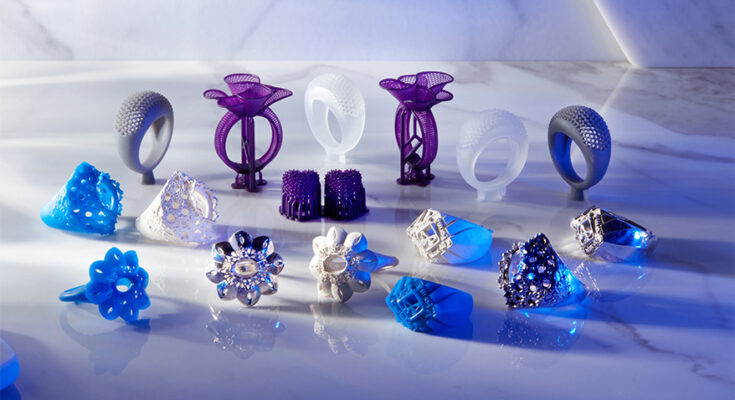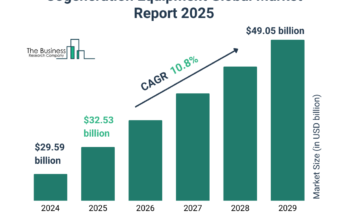The 3D Printed Jewelry Global Market Report 2024 by The Business Research Company provides market overview across 60+ geographies in the seven regions – Asia-Pacific, Western Europe, Eastern Europe, North America, South America, the Middle East, and Africa, encompassing 27 major global industries. The report presents a comprehensive analysis over a ten-year historic period (2010-2021) and extends its insights into a ten-year forecast period (2023-2033).
Learn More On The 3D Printed Jewelry Market:
https://www.thebusinessresearchcompany.com/report/3d-printed-jewelry-global-market-report
According to The Business Research Company’s 3D Printed Jewelry Global Market Report 2024, The 3D printed jewelry market size has grown rapidly in recent years. It will grow from $3.04 billion in 2023 to $3.57 billion in 2024 at a compound annual growth rate (CAGR) of 17.5%. The growth in the historic period can be attributed to the use of eco-friendly materials and reduced waste, reduced production costs compared to traditional methods, the integration of 3D printing in design and jewelry-making education, empowering designers to explore innovative forms and faster turnaround times for design iterations.
The 3D printed jewelry market size is expected to see rapid growth in the next few years. It will grow to $6.85 billion in 2028 at a compound annual growth rate (CAGR) of 17.7%. The growth in the forecast period can be attributed to the growing preference for sustainable manufacturing processes, increasing demand for personalized and bespoke jewelry, alignment with consumer preferences for unique and trendy jewelry designs, the ability to quickly iterate and produce prototypes for new designs, and the expansion of online platforms and e-commerce for selling custom jewelry. Major trends in the forecast period include the integration of AI and machine learning, technologies that enable faster printing processes and higher production rates, advancements in material innovation, utilization of the Internet of Things (IoT) for smart jewelry applications, and the introduction of materials suitable for medical and wearable tech applications.
Rising demand for fashion-forward accessories is expected to propel the growth of the 3D printed jewelry market going forward. Fashion-forward accessories are stylish and trend-setting items that reflect the latest fashion trends and innovative designs. The demand for fashion-forward accessories is growing due to increasing consumer interest in personal expression and trend-driven styles. 3D-printed jewelry enables rapid and cost-effective production of unique, customizable designs, driving innovation and accessibility in fast fashion accessories. For instance, in March 2023, according to the Silver Jewelry Sales Results 2022 report published by The Silver Institute, a US-based nonprofit association, 52% of retailers reported an 11-25% increase in silver jewelry sales in 2022 compared to 2021, with an average increase of 14%, and noted higher sales during the 2022 holiday season compared to the 2021 holiday season. Therefore, rising demand for fashion-forward accessories is driving the growth of the 3D printed jewelry market.
Get A Free Sample Of The Report (Includes Graphs And Tables):
https://www.thebusinessresearchcompany.com/sample.aspx?id=18205&type=smp
The 3D printed jewelry market covered in this report is segmented –
1) By Product: Necklace, Ring, Earring, Bracelet
2) By Material: Gold, Silver, Brass, Bronze, Polyamide, Wax, Alumide, Other Materials
3) By Technology: Stereolithography (SLA), Selective Laser Sintering (SLS), Digital Light Processing (DLP), Fused Depositing Modelling (FDM), Other Technologies
4) By Application: Prototyping, Functional Part Manufacturing, Tooling
5) By End User: Jewelry Store, Mall, Other End Users
Major companies operating in the 3D printed jewelry market are developing innovative solutions, such as carbon border adjustment mechanism (CBAM) technology, to enhance durability and offer unique, lightweight designs. The carbon border adjustment mechanism (CBAM) technology refers to a regulatory framework that ensures imported 3D-printed jewelry meets specific carbon emission standards, promoting sustainable manufacturing practices. For instance, in November 2021, LACE, a US-based brand specializing in 3D-printed luxury fine jewelry, launched a new series of fine statement pieces and engagement rings made with carbon fiber. This collection features four 3D-printed jewelry pieces created with carbon fiber composite material, using Impossible Objects’ CBAM technology to produce intricate, durable, and lightweight designs. This innovation enables the production of complex, curved jewelry that was previously impossible using traditional methods. It showcases the potential of advanced materials and additive manufacturing to elevate the 3D printed jewelry market into a realm of luxury and everyday wearable art.
The 3d printed jewelry market report table of contents includes:
1. Executive Summary
2. 3D Printed Jewelry Market Characteristics
3. 3D Printed Jewelry Market Trends And Strategies
4. 3D Printed Jewelry Market – Macro Economic Scenario
5. Global 3D Printed Jewelry Market Size and Growth
.
.
.
32. Global 3D Printed Jewelry Market Competitive Benchmarking
33. Global 3D Printed Jewelry Market Competitive Dashboard
34. Key Mergers And Acquisitions In The 3D Printed Jewelry Market
35. 3D Printed Jewelry Market Future Outlook and Potential Analysis
36. Appendix
Contact Us:
The Business Research Company
Europe: +44 207 1930 708
Asia: +91 88972 63534
Americas: +1 315 623 0293
Email: info@tbrc.info
Follow Us On:
LinkedIn: https://in.linkedin.com/company/the-business-research-company
Twitter: https://twitter.com/tbrc_info
Facebook: https://www.facebook.com/TheBusinessResearchCompany
YouTube: https://www.youtube.com/channel/UC24_fI0rV8cR5DxlCpgmyFQ
Blog: https://blog.tbrc.info/
Healthcare Blog: https://healthcareresearchreports.com/
Global Market Model: https://www.thebusinessresearchcompany.com/global-market-model




